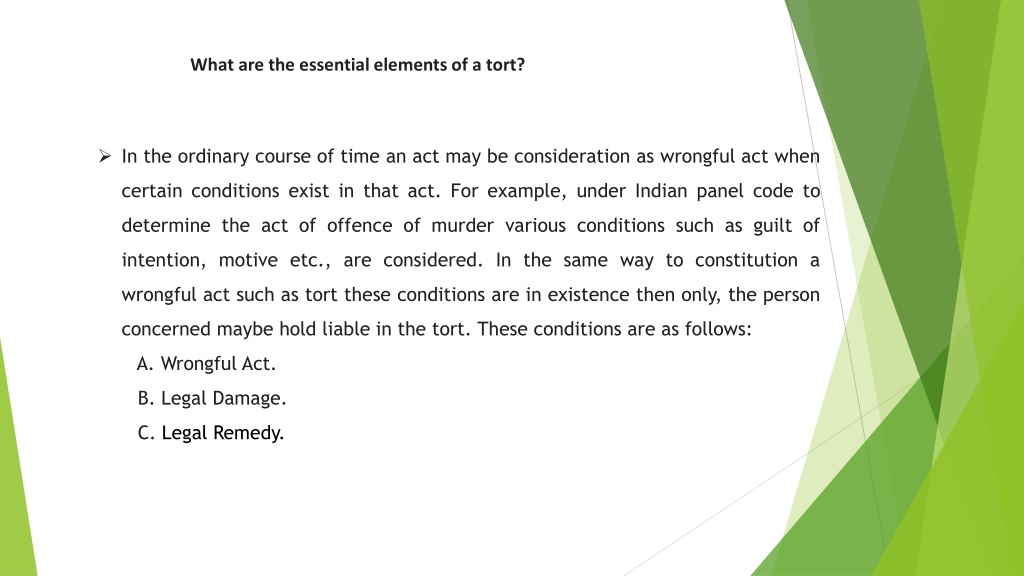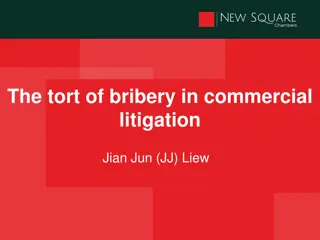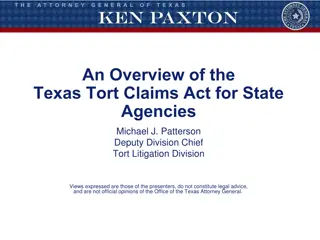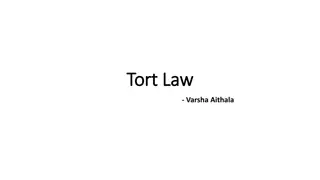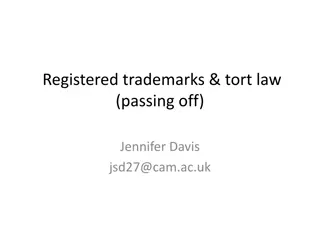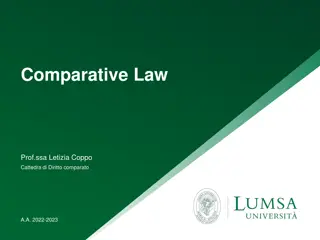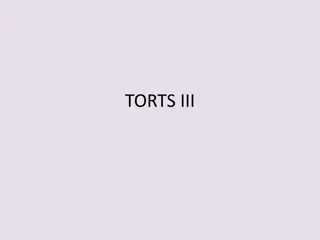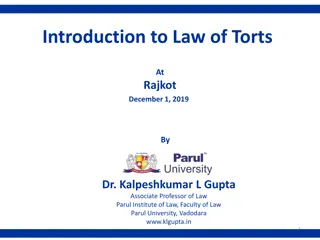Essential Elements of a Tort in Indian Law
The essential elements of a tort under Indian law include a wrongful act, legal damage, and legal remedy. A wrongful act is one that violates another's legal rights, while legal damage refers to harm caused by the wrongful act. The concept of "damnum sine injuria" is also crucial in determining legal damage. An example from the Gloucester Grammer School case illustrates how not every loss results in a tort action if there is no violation of legal rights.
Download Presentation

Please find below an Image/Link to download the presentation.
The content on the website is provided AS IS for your information and personal use only. It may not be sold, licensed, or shared on other websites without obtaining consent from the author.If you encounter any issues during the download, it is possible that the publisher has removed the file from their server.
You are allowed to download the files provided on this website for personal or commercial use, subject to the condition that they are used lawfully. All files are the property of their respective owners.
The content on the website is provided AS IS for your information and personal use only. It may not be sold, licensed, or shared on other websites without obtaining consent from the author.
E N D
Presentation Transcript
What are the essential elements of a tort? In the ordinary course of time an act may be consideration as wrongful act when certain conditions exist in that act. For example, under Indian panel code to determine the act of offence of murder various conditions such as guilt of intention, motive etc., are considered. In the same way to constitution a wrongful act such as tort these conditions are in existence then only, the person concerned maybe hold liable in the tort. These conditions are as follows: A. Wrongful Act. B. Legal Damage. C. Legal Remedy.
A. Wrongful Act. An act which is done with out any lawful consideration can be called as wrongful act. To hold a person liable in tort, such wrongful act must be proved. A wrongful act is one which violates the legal right of another, violation of moral, social, and religious duties does not come under the category of tort, Thus in tort the plaintiff has to prove that his legal rights have been violated by the act of the defendant.
B. Legal Damage Damage means the harm or injury caused to one person by the wrongful act of the other. It is different from Damages which means the compensation which is given to a person for the harm or injury that was caused to him due to the wrongful act of another. In the eyes of law for every damage compensation is not given. Only in case of legal damage damages may be given as compensation. The real meaning of legal damage may be ascertained by the following two maxims: -Damnum Sine Injuria. -Injuria Sine Damnum.
Damnum sine injuria The meaning of the above maximum is as follows considered DAMNUM : the term damnum means damage in the form of money comfort and health SINE : The terms sine means without INJURIA : The term injuria means violation of legal rights The three terms in the above maxim together gives the meaning that a damaged that cause in the form of money, comfort and health without the violation of legal rights
GLOUXESTER GRAMMER SCHOOL CASE, 1410 According to the facts of the case, the plaintiff was running the school and the place later on, the defendant started another school near the school of the plaintiff as a result of this most of the students of the plaintiff left the plaintiffs school and joined defendants school. To meet the competition the plaintiff reduced their fees from 40 penie to student per quater. Thus the plaintiff suffered huge amount of loss then the plaintiff filed a Suit against the defendant for compensation. where both the plaintiff and defendant have the legal right to establish a school, which the exercised respectively even though the establishment of new school near the plaintiff causes some monetary loss, no legal right of a plaintiff was violated according to the Maxim damnum sine injuria. A claim for damage which is in the form of money, comfort and health without violation legal right cannot be entertained as it talk show in this case it was held that no action can be against the defendant.
B. INJURIA SINE DAMNUM Injuria sine damno means injury without damage. Such damage is actionable under the law of torts. It occurs when a person suffers a legal damage instead of actual loss, i.e. his legal right is infringed by some other individual. In other words, this is an infringement of an absolute private right of a person without having suffered any actual loss.
An example of this can be the landmark case of, Ashby v. White(1703) 92 ER 126, where Mr. Ashby, the plaintiff, was prevented from voting by the constable Mr. White. This rule is basically based on the old maxim Ubi jus ibi remedium which translates to where there is a right, there will be a remedy. Another example in the Indian context would be the case of,Bhim Singh v. State of J and K, where the plaintiff was a Member of the parliament and was not allowed to enter into the premises of the Assembly election by a police constable, hence his legal right was infringed.
